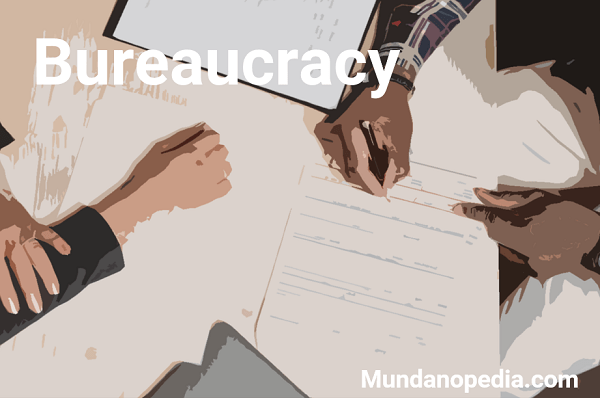Bureaucracy, Max Weber's Theory and Formal Organizations

Bureaucracy
Bureaucracy is the rationalization of activities through rules and procedures to achieve the greatest possible efficiency within an organization or business. The RAE defines it as “the organization regulated by rules that establish a rational order to distribute and manage the matters that are its own.” (1)
The bureaucracy is more present in some organizations than in others to the extent that it complies to a greater or lesser degree with its characteristics, and even within the same organization there may be variations in its influence.
Contents
Bureaucracy and the bureaucratic model of Max Weber
Max Weber‘s bureaucratic model is a theoretical conception of the ideal formal organization type and is currently the best-known organizational model. He conceives of the bureaucracy according to the definition seen before, but emphasizes that these processes occur within a structure of legal authority and following terms arise:
- Authority: It is the probability that certain orders from a legitimate source will be obeyed voluntarily because said source is considered legitimate.
- Power: Power is the ability to enforce the will even if there is resistance.
Related: Formal organization.
Difference between Authority and Power
Authority differs from other types of social influence, such as power, because with power the will of the person ordering is enforced despite resistance. On the other hand, with authority there is no resistance and the source is viewed as legitimate. The authority can come from a person or from an impersonal entity, an example of the first is a worker and the second is the legal system of a country.
In an organization, authority takes place when subordinates voluntarily comply with the orders of their superior. According to Weber, it is the values and beliefs of the group that give authority legitimacy.
See more about the differences between authority and power
Characteristics of the bureaucracy
According to Max Weber, bureaucracy has seven fundamental characteristics.
- Specialty. It is having the capacity and specialization to do the job.
- Professionalism. It is that those who occupy the positions are highly qualified professionals.
- Rationality. The organization plans and acts according to guidelines based on logic and efficiency.
- Impersonality. The authority depends on the position and not on the person.
- Hierarchy. Positions and offices have different ranks, one higher than the other.
- Stability. It is the guarantee of permanence within the organization in the exercise of the corresponding positions.
- Autonomy. It consists in the fact that individuals can make decisions within the limits of their functions and nature of their activities.
Types of authority
It is the values and beliefs of the group that give legitimacy to the authority and from there arise three types of authority that are distinguished by said values and beliefs. The types of authority are traditional authority, charismatic authority and legal authority.
Traditional authority
It is based on the divine and sacred, so whoever exercises authority is seen as such, there are beliefs about the sacred, such as the case of the pope, and it contributes to the perpetuation of the existing social order.
Charismatic authority
In contrast, it rejects and opposes the traditional and tries to change the social order, there is a perception that the leader brings new and better realities, an example of this is Martin Luther King.
Legal authority
The legal authority that is the one that emanates from a body of norms that have been created to regulate the conduct of man in society, norms created by men and following an established procedure; obedience is due to impersonal norms, not to individuals.
It is the legal authority that gives rise to the bureaucratic organization, which, as said, is rationally generated to achieve efficiency; it is the formal organization through its rules that grants authority.
Criticism of Weberian Bureaucratic Theory
The bureaucratic model is criticized mainly by scholars of human behavior, who argue that the model ignores the informal organization. They claim that it conditions and limits the personality of people, that it makes it difficult to adapt to change, and that it causes dysfunctions in the organization.
Other approaches or theories of the formal organization
The decision-making theory
In addition to Weber, the author Herbert Simón treats the structure with another approach; he sees it as a decision-making structure where each person, according to certain guidelines, makes satisfactory decisions based on known alternatives. He emphasizes that satisfactory decisions are made and not necessarily the optimal ones or the best ones, since in his opinion that can be very expensive.
Theory of the organization as a social system
Another author, Talcott Parsons, sees the organization as a subsystem within a larger system that is society, where it has the functions that allow it to achieve its objectives by adapting to that environment.
See also